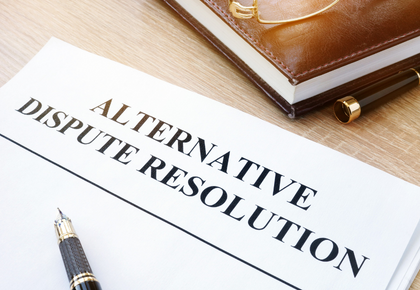Conflict Resolution for Condo and HOA Community Association Board Members
 In an ideal world, all stakeholders in a condo or homeowners association (HOA) would always agree and work well together. In the real world, however, community association disagreements and disputes are inevitable. And while the parties involved often settle their differences through open and honest discussion or negotiation, sometimes additional strategies are needed to help them agree. In our latest Board Brief, our industry experts discussed strategies to help board members manage conflicts productively and efficiently. Keep reading to learn how your board can handle disputes when they arise.
In an ideal world, all stakeholders in a condo or homeowners association (HOA) would always agree and work well together. In the real world, however, community association disagreements and disputes are inevitable. And while the parties involved often settle their differences through open and honest discussion or negotiation, sometimes additional strategies are needed to help them agree. In our latest Board Brief, our industry experts discussed strategies to help board members manage conflicts productively and efficiently. Keep reading to learn how your board can handle disputes when they arise.
Conflict Types and Causes
Board members face many types of conflicts, from differences with residents over fines or dues to billing disputes with vendors and even disagreements with each other. These conflicts can happen anytime and can range from minor disputes to long-term grievances, or even violent confrontations.
Conflicts are rooted in dissatisfaction and frustration among individuals who are unable to achieve their desired outcome. This can be due to different beliefs or values, miscommunication or misunderstanding, rigid expectations from either party, lack of trust between participants, or simple personality clashes. A lack of board alignment can even lead to conflict between board members.
Board members who can’t resolve conflicts quickly through dialogue or compromise may require a deeper understanding of why the conflict is happening and may need to try a specialized approach using different tools and techniques to resolve them. A quality property management company can guide and support your board in resolving conflicts unique to your community.
“A conflict is more than just a disagreement,” said David Astrello, regional director at FirstService Residential. It’s a situation in which one or both parties perceive a threat, whether or not the threat is real. And because conflicts involve perceived threats to our well-being and survival, they stay with us until we face and resolve them.”
Tips for resolving conflict
What can board members do to resolve some of the challenging issues affecting their community? Where is a good place to start? The most useful starting point is to try to avoid conflict in the first place. However, here are some tips to help you manage conflicts when they arise.
1. Use clear communication.
Healthy communication is key to successfully managing your condo or community association. As associations routinely inform members about changes to the association's rules and provide other significant information, clear written and verbal communications are essential to help prevent misunderstandings. It’s also important that board members communicate with residents without using overly technical or complex legal language. Board members should always be professional, using simple, direct communication. Clear and open communication can enhance trust between the association and its members.
2. Define expectations to establish a baseline of what is expected.
Clarifying expectations helps ensure everyone understands the goals that need to be met, which helps create a sense of shared responsibility. The most effective way to build mutually clear expectations with others is to define them – and agree on them – beforehand.
3. Find common ground.
Address the situation head-on by getting right to the point. Acknowledge your differences and let the other person know you want to find a resolution. Remember to stay calm and empathetic, show genuine interest and actively listen to what the other party has to say. Ask open-ended questions without judgment, and try not to jump to conclusions.
“Always remain professional and listen, listen, listen,” said Astrello. “Remember that conflicts are opportunities for growth. Familiarize yourself with common pitfalls and issues within your community and think of ways to collaborate or compromise. By finding common ground, you may be able to resolve the conflict through friendly discourse and good faith.”
Download our infographic, The Do’s and Don’ts of Board Communication to help ensure you’re getting the right message across to residents.
Alternative Dispute Resolution
 One beneficial way to resolve differences is through Alternative Dispute Resolution (ADR). ADR typically denotes a wide range of dispute resolution processes and techniques that parties can use to settle disputes with the help of a third party. The methods help the parties involved resolve their disagreements without resorting to litigation.
One beneficial way to resolve differences is through Alternative Dispute Resolution (ADR). ADR typically denotes a wide range of dispute resolution processes and techniques that parties can use to settle disputes with the help of a third party. The methods help the parties involved resolve their disagreements without resorting to litigation.
Mediation is often considered a non-adversarial, effective and cost-efficient method of ADR. An independent and neutral third party – a mediator – facilitates the entire process. This third party works with both sides to discuss the issues at hand and come to a resolution. A mediator is not a judge, so rather than choosing sides or determining outcomes, they help both parties reach an agreement that all consider satisfactory and fair. Neither party is forced to accept a mediation decision and may leave the mediation process at any time if they feel it does not serve their needs.
Arbitration is a less formal version of a court trial and is considered an adversarial form of ADR. It is mandated in some states for certain types of associations and is facilitated by an arbitrator (sometimes more than one), whose role is similar to that of a private judge, and attorneys represent both sides. After listening to evidence, hearing sworn testimony from witnesses and reviewing relevant documents, the arbitrator makes a final decision, which may be binding or non-binding, depending on what both sides have agreed to in advance or what is required by law. A binding arbitration is a final decision that neither party can appeal and with which both parties must comply. Non-binding arbitration is a type of arbitration in which the arbitrator determines the rights of the parties to the dispute. Still, this determination is not binding upon them, and no enforceable arbitration award is issued. The parties can abide by the arbitrator’s decision or proceed with binding arbitration or litigation.
“Litigation can be costly and time consuming to the association,” said Jacqueline Cress, regional director at FirstService Residential. “As a board member you want to avoid litigation by understanding the grievance and resolving your differences at the association level. ADR can be cost-efficient, time-effective, and give the parties involved more control over the process.”
Did you know that even a simple email blunder can lead to conflicts in your community? Avoid common email mistakes and potential conflicts by downloading this infographic.
But what if a resolution can’t be reached through any of the processes above? The next step is courtroom litigation, complete with judges, juries and lawyers. Talk to your association’s attorney about your specific conflict to determine which course of action is best for you, and work with your property management company to learn additional best practices specific to your community.